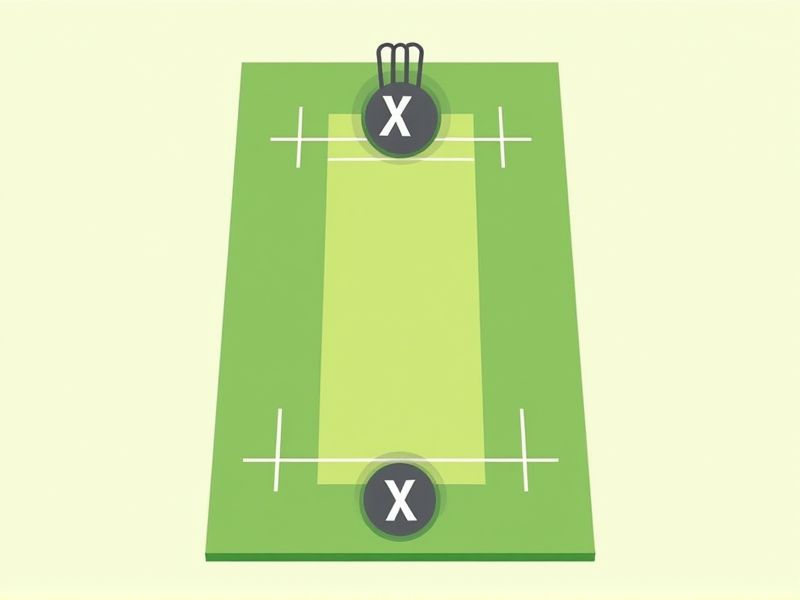
A standard cricket pitch measures 22 yards (20.12 meters) in length and 10 feet (3.05 meters) in width. The stumps at either end are set 9 inches (22.86 centimeters) wide, and the popping crease is marked 4 feet (1.22 meters) in front of each set of stumps. These measurements ensure a consistent playing area that meets the requirements of the Laws of Cricket. Following these standard dimensions is crucial for fair play and for organizing matches at any level.
Length Between Wickets
The standard length of a cricket pitch measures 22 yards, or 20.12 meters, between the two sets of wickets. Each wicket stands at 28 inches (71.1 cm) high and consists of three stumps and two bails. Proper maintenance of the pitch's surface is critical, influencing the game's dynamics, such as bounce and spin. A well-prepared pitch can significantly impact player performance, showcasing the importance of this 22-yard stretch in cricket.
Width Of The Pitch
The standard width of a cricket pitch is 10 feet (3.05 meters), which is essential for maintaining consistency in gameplay. This measurement ensures that bowlers can deliver overarm throws effectively, while batsmen have ample space for lateral movement. A pitch of this width enables fair competition, allowing players to showcase their skills without the constraints of an overly narrow area. Proper pitch width is crucial in both amateur and professional matches, influencing the game's dynamics significantly.
Distance Between Creases
The distance between the two sets of creases on a standard cricket pitch is precisely 22 yards, or 20.12 meters. This measurement plays a crucial role in the game, as it defines the playing area for bowlers and batsmen. The bowling crease, batting crease, and popping crease are all marked within this 22-yard framework, ensuring consistent gameplay across all levels of cricket. Understanding this standard is essential for players, as it affects tactics and strategies during matches.
Size Of Crease Markings
A cricket pitch measures 22 yards in length, with the crease markings being crucial for game play. There are two primary creases: the bowling crease, which lies at each end of the pitch, marked 8 feet 8 inches from the stumps, and the popping crease, set 4 feet in front of the stumps, providing a safety zone for the batsman. The width of both the bowling and popping creases is 4 feet, while the return crease extends 4 feet 4 inches behind the stumps, serving as a boundary for the bowler's run-up. Properly maintained crease markings are essential for ensuring fair play and upholding the standards set by the International Cricket Council (ICC).
Width Of Bowling Crease
The width of the bowling crease on a cricket pitch measures 4 feet (1.22 meters), playing a crucial role in defining the legal delivery zone for bowlers. This specific dimension ensures that bowlers deliver their balls consistently without stepping over the line, maintaining fair play throughout the match. When you observe fast bowlers, their precision in adhering to this regulation can significantly impact their performance and the overall game strategy. Compliance with the 4 feet width also aids umpires in making accurate decisions regarding no-balls, thus preserving the integrity of the sport.
Width Of Popping Crease
The width of the popping crease on a standard cricket pitch measures 4 feet (1.22 meters). This essential marking is located at both ends of the pitch, ensuring that players can establish their safe zone while batting or running between the wickets. The accuracy of the popping crease is crucial for determining run-outs and the legality of various plays, contributing to the fairness of the game. Understanding the dimensions of the popping crease helps players refine their techniques and strategy on the field.
Size Of Return Creases
The return creases on a cricket pitch are essential for defining the bowler's area, measuring 4 feet (1.22 meters) in length from the stumps. Positioned parallel to the wicket on both sides, each return crease is 4 feet 4 inches (1.32 meters) from the outer edge of the stumps. These creases ensure that bowlers maintain proper foot placement while delivering the ball, which is crucial for fair play and safety. Understanding the dimensions and purpose of return creases can enhance your appreciation of the game's technical aspects.
Stump Height
The standard height of cricket stumps is 28 inches (71.1 cm), with a diameter of 3 inches (7.6 cm). The three stumps are placed equidistant from each other, forming a total width of 9 inches (22.9 cm). Properly maintained, the stumps enable accurate adjudication in game scenarios, emphasizing their significance in determining runs and dismissals. Each cricket pitch maintains regulations to ensure uniformity in play conditions, which directly influences performance outcomes for players and teams alike.
Stump Width
The standard width for a cricket pitch stump is 10 centimeters, crucial for maintaining consistent gameplay. This width ensures that bowlers and batsmen can easily interact with the ball while providing a clear target for wicketkeepers. Properly measured stumps, which feature a total of three positioned vertically, stand at a height of 71.1 centimeters above the ground. Maintaining this standard is essential for upholding the integrity of the game and creating a fair environment for all players.
Bails Length
In standard cricket pitches, the bails are crucial for determining the status of a wicket, typically measuring 4.31 inches (11 cm) in length. They sit atop the stumps, which are 28 inches (71.1 cm) high, and play a significant role in signaling a bowled dismissal. The bails dislodge easily when struck by the ball, with the precise balance between weight and design ensuring consistent performance across various conditions. Proper maintenance of bails, including regular checks for wear, can enhance your game experience and uphold the integrity of cricket matches.
